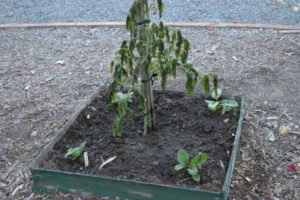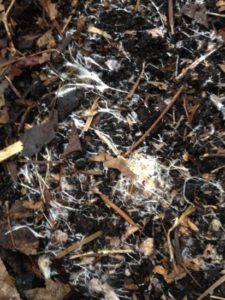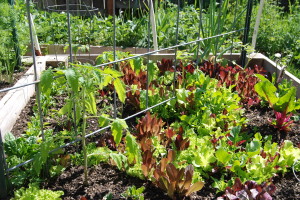Spring is officially here – the garden centers, nurseries, and big-box stores are overflowing with a plethora of plants and flowers. Oooh, the temptation is great to start buying and planting!
Don’t Be Too Eager
But hold on…don’t get too overzealous – it’s still too early to plant those warm season vegetables (like tomatoes, peppers), herbs (basil), or flowers (petunias and hanging basket assortments). Only purchase these now if you have a greenhouse or suitable cold frame to store them in. Even then, I would recommend waiting a few more weeks.

This tomato was planted too soon and has been damaged by frost. Note the cool-season plants in the bed were not effected.
Warm season crop are extremely frost intolerant and our region’s last average day of frost isn’t until May 15th. Given our unpredictable spring weather, the planting time for these crops may even be a week or two later. Just don’t rush it or you’ll be back buying more plants.
Ready, Set, Dig In!
The good news is that it is time to plant cool season crops. Yay! Dirt covered hands rejoice! If you soil is workable, you can start planning and planting your early spring garden now.
Let’s talk a minute about what “workable” soil means. Your garden soil should be moist and crumbly when you pick it up in your hand. When you squeeze a handful, it should crumble apart. If it sticks together and forms a ball, or worse yet, water runs out, it’s not ready for planting. Working in wet soil will only create clumps that dry into hard marble-like orbs. Let the soil dry a bit more before working it.

Mycorrhizae, a beneficial fungi, is the white-ish, threadlike substance you find in your garden beds. Rototilling destroys this.
And here’s some good news, unless you are creating a new garden plot, there is no need to rototill your garden before planting. This will probably be a great relief to those spouses who have been bribed, cajoled, or otherwise forced to perform this chore.
The fact is, rototilling can actually do more harm than good to established garden beds. While you think you are “fluffing” the soil, you’re actually breaking down the soil’s structure and removing air pockets necessary for good plant growth and water drainage; you’re disturbing the mycorrhizae (important and beneficial fungi) that live in the soil, and in the very least, you’re mutilating (and killing) earthworms that nourish the soil. Perhaps the worst thing about rototilling is that it brings dormant weed seeds to the surface – and no one wants that!
A better option is to lightly turn the top few inches soil with a spade or fork, plant your seeds or transplants, and then top-dress the soil with a 2 to 4 inch layer of good compost. Really, that’s all that is needed.
Cool Season Crops to Plant Now
Most cool season crops can withstand a little frost, and as their name implies, they do very well with cooler temperatures. They still need at least 6 hours of sunlight (8 or more hours is better), so make sure your garden plot gets enough sunlight.

Here, spring lettuces grow next to tomatoes. By the time the lettuce is finished, the tomatoes will have taken over the garden bed.
Most cool season crops grow poorly in summer’s heat, but this isn’t a problem, it’s an opportunity. As these crops are winding down, you can inter-plant your warm season vegetables and herbs alongside. For example, you may replacing rows of spent lettuces with tomatoes or beans. The bonus with cool season crops is that they can make a repeat appearance in your garden in late summer as the temperatures begin to cool. Replanting spinach, kale, and lettuces in September, as those warm season crops are dwindling, will give you fresh greens right up to Halloween!
Here’s a short list of cool-season vegetables and herbs that can be planted now:
| • Lettuces & salad greens | • Arugula |
| • Chard | • Spinach |
| • Kale | • Peas |
| • Carrots | • Beets |
| • Onions, scallions, and leeks | • Radishes |
| • Cabbage | • Broccoli |
| • Parsley | • Chives |
| • Cilantro | • Rosemary |
So, what are you waiting for?? Get your plan together and get gardening already!!
Got gardening questions? Comment below or contact me here. — Candace


Leave a Reply